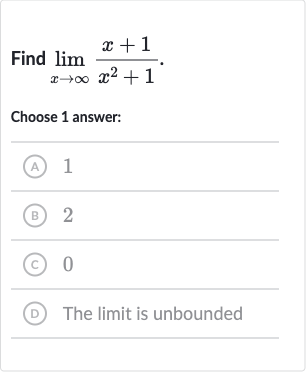Full solution
Q. Find .Choose answer:(A) (B) (C) (D) The limit is unbounded
- Analyze Behavior of Functions: We are asked to find the limit of the function as approaches infinity. To do this, we will analyze the behavior of the numerator and the denominator separately as grows without bound.
- Degree of Polynomials: The degree of the polynomial in the numerator is (since the highest power of is ), and the degree of the polynomial in the denominator is (since the highest power of is ). When the degree of the denominator is higher than the degree of the numerator, the limit as approaches infinity is .
- Divide Numerator and Denominator: To formally show this, we can divide both the numerator and the denominator by , the highest power of in the denominator. This will give us:
- Simplify Expression: Simplifying the expression inside the limit, we get: .
- Apply Limit as x Approaches Infinity: As approaches infinity, and both approach . Therefore, the expression simplifies to: .
- Final Limit Calculation: The limit then becomes: .
More problems from Find limits of polynomials and rational functions
QuestionGet tutor help
QuestionGet tutor help

